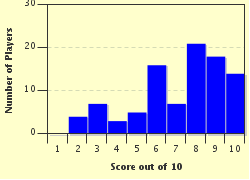Quiz Answer Key and Fun Facts
1. The largest moon of Uranus was also one of the first to be discovered when it was spotted by the astronomer Sir William Herschel in 1787. Given that it is named after the Queen of the Fairies from Shakespeare's 'A Midsummer Night's Dream', can you pick it out from the options below?
2. The tallest cliff in the solar system is believed to be the Verona Rupes. It is located on a moon of Uranus that is named after the only female character to appear in William Shakespeare's 'The Tempest'. What is the name of the moon in question?
3. Uranus has a lot of inner moons that tend to have prograde, low-inclination orbits. The largest of these shares its name with which alternative name for Robin Goodfellow, a character from 'A Midsummer Night's Dream'?
4. The moons originally designated S/1997 U1 and S/1997 U2 are relatively modern additions to the list of those belonging to Uranus, having been first spotted in 1997. Clearly those names were not very catchy so they were quickly exchanged for those of a son and his mother from Shakespeare's 'The Tempest'. By what names are they now known?
5. Nine of Uranus's collection of small inner moons are generally considered as a group, as they have similar orbits and characteristics. The group takes its name from that of the largest of the nine, which was named after the heroine of 'The Merchant of Venice'. What is the group called?
6. In addition to its many moons, Uranus also has a number of planetary rings which are named after numerals and Greek letters. Uranus's epsilon ring is both the brightest of these features and the only one to have a pair of shepherd moons. What is the name of the outer shepherd moon of the epsilon ring that is named after a fictitious Danish noblewoman from Shakespeare's 'Hamlet'?
7. The innermost of Uranus's moons orbits the planet at a distance of about 50,000 km (31,000 miles). What is the name it shares with the youngest daughter of Shakespeare's eponymous King Lear?
8. A small moon of Uranus, probably less than 50 km (30 miles) in diameter, was discovered in 2003 using pictures taken by the Hubble Space Telescope. Its orbit coincides with one of the planet's dusty rings. After which fairy from Shakespeare's famous play 'Romeo and Juliet' is this moon named?
9. One of Uranus's small outer moons stands out from the crowd because it is the only one that has prograde motion and has one of the most 'eccentric' orbits of any moon in the solar system. It is named after Hero's servant in 'Much Ado About Nothing', but more famous namesakes include a British Prime Minister, a Booker Prize winning Canadian author and the wife of King Henry VI of England. Can you name it?
10. Very little is known about most of Uranus's outer or 'irregular' moons as they are small, dark and relatively recently discovered. They are thought to have originated from objects captured by Uranus's gravitational forces. One of the smallest moons of Uranus falls into this category and is named after a jester from William Shakespeare's 'The Tempest'. Can you identify it?
Source: Author
Fifiona81
This quiz was reviewed by FunTrivia editor
rossian before going online.
Any errors found in FunTrivia content are routinely corrected through our feedback system.

